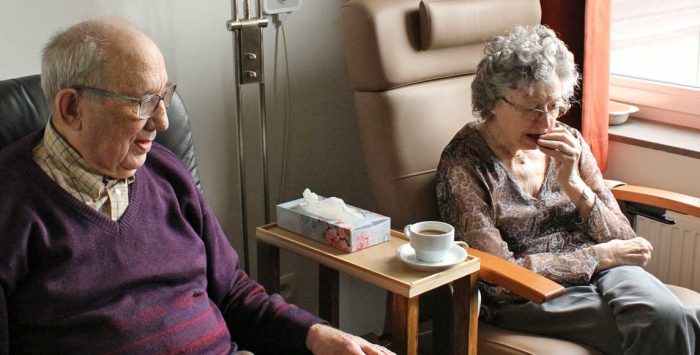In the end, our family’s solution felt like putting together a puzzle. We relied upon multiple family members, respite care providers and home care professionals to provide my grandmother the care she required.
The financial resources to pay for care also changed over the years. We combined Medicare’s assistance with a veteran’s aid program and over time, she became eligible for an increasing level of public assistance. Ultimately, we were fortunate to be able to provide for my grandmother in the location of her choosing. But it wasn’t easy, and it was definitely a confusing journey.
In hindsight, our confusion about how Medicare works with long-term care shouldn’t have surprised me, as I was unaware of even the basic terminology associated with long-term care.
And sadly, I know from my own experience talking with hundreds of families over the years, that most Americans end up facing the prospect of long-term care without even this basic understanding. They find themselves trying to problem solve before they’re even familiar with the problems.
The good news is that while Medicare’s role in long-term care is complicated, you can head off much of the headache that comes with the financial burden of long-term care by understanding these basic concepts:
The basics of paying for long-term care
Custodial care refers to personal care given to individuals to help them with activities of daily living (ADL), which include bathing, dressing, and transferring themselves from seated to standing or in and out of bed. Also known as non-medical care, custodial care can be, and frequently is, provided by persons without professional medical training.
Skilled care, on the other hand, requires the provider to have professional medical training and licenses. In a home environment, the distinction between who is providing these types of care is fairly clear. In a hospital environment, it is less evident. Nurses, for example, provide both medical and custodial care at the same time, especially in smaller hospitals.
In the past, the simplest test to determine whether Medicare would or would not pay for care was to consider whether the care being provided was custodial/personal care or medical/skilled care. Up until a recent announcement in regards to Medicare Advantage (MA), Medicare would not cover the custodial care, but would pay for skilled care (or at least a portion of it). That said, original Medicare will still only pay for skilled care (in part), but the rules of long-term care are more relaxed for MA.
In April of 2018, the Centers for Medicare and Medicaid Services (CMS) made policy changes that allow Medicare Advantage plans to cover supplemental healthcare benefits. Previous to this announcement, benefits of “daily maintenance” were not covered under MA. However, starting in 2019, MA plans are able to offer healthcare benefits that better the functional impact of health issues or reduce the need for the usage of health and emergency services.
The intention is to better the quality of a MA recipient’s life and for them to have better health outcomes. Therefore, a variety of home and community-based services are available on some MA plans. But uptake of this provision among MA insurers has been fairly slow. As of 2021, only 6% of MA plans provide coverage for in-home support or bathroom safety provisions.
Long-term care scenarios
Unfortunately, these seemingly uncomplicated distinctions become more complicated, especially as the patient’s need for care changes from temporary to long-term.
For Original Medicare to pay for care provided in the home, it must be medical care, prescribed by a doctor, and on a part-time basis. The individual must also be “confined,” which means they are unable to leave their home without assistance. For Medicare Advantage, it is more lenient, but still, a licensed provider needs to recommend the services and deem them medically necessary. (This holds true for all supplemental health care benefits to be provided by Medicare Advantage).
In adult daycare, most, if not all of the care being provided is considered non-medical – and therefore, Original Medicare does not pay for it. However, there are now adult day health care (ADHC) centers that provide medical care as well as non-medical. In these environments, if the care is prescribed and medically necessary, it falls within Medicare’s coverage guidelines. In addition, starting in 2019, some Medicare Advantage plans may cover adult day care under the new supplemental health care benefits.
The same applies to assisted living communities, which have, over time, increasingly offered medical services. Original Medicare, and most likely, Medicare Advantage, will pay for those services, but not for the costs of room and board.
Other long-term care benefits that may be provided through supplemental healthcare benefits via Medicare Advantage plans include respite care, meal delivery, and both medical and non-medical transportation. As of 2021, transportation and meal benefits are much more common on Medicare Advantage plans than in-home support services.
Skilled nursing facilities rules more complex
The rules involving Medicare and nursing homes or skilled nursing facilities are more complex.
Original Medicare and Medicare Advantage will pay for the cost of skilled nursing, including the custodial care provided in the skilled nursing home for a limited time, provided 1) the care is for recovery from illness or injury – not for a chronic condition and 2) it is preceded by a hospital stay of at least three days.
For the first 20 days, Medicare will pay for 100% of the cost. For the next 80 days, Medicare pays 80% of the cost. Skilled nursing beyond 100 days is not covered by Original Medicare.
Individuals who have a Medicare Advantage plan have at least the same coverage as mentioned above, and perhaps, have additional coverage. In addition, persons with certain types of Medicare supplemental insurance can get additional assistance towards defraying the cost of nursing home/skilled nursing care. Some plans will cover 100% of the coinsurance payment required by Medicare. This means that between Medicare and the Medigap plan, 100% of the cost of skilled nursing for 100 days will be covered.
Beyond Medicare assistance
Although Original Medicare’s overall benefits are limited for long-term care, Medicare Advantage is evolving. In addition, there are many other state and federal public assistance options that can help. There are financial resources from non-profits, foundations, and the Veteran’s Administration as well as private loan options that can help.
Some people choose to purchase private long-term care insurance, which will cover varying amounts of the cost of long-term care if and when you need it. This is a decision that should be made in conjunction with an analysis of your overall financial picture, as long-term care insurance is fairly expensive.
Medicaid is a useful means of paying for long-term care for low-income seniors and those who have exhausted their assets. In fact, six out of ten nursing home residents are covered by Medicaid, usually in addition to Medicare. Based on functional and financial need, assistance with a variety of long-term care needs is provided through state Medicaid plans and home and community-based services (HCBS) Medicaid waivers. This support – based on your Medicaid eligibility – could come in the form of personal care assistance, companionship care, respite care, adult daycare, meal delivery, nursing home care, and more.
As always, it’s well worth your time to research online resources – including this Resource Locator Tool – to determine whether you or your loved one are eligible for resources that can help pay for assisted living or pay for home care.
Select your state on this map to see how Medicaid can provide assistance in conjunction with your Medicare coverage.



